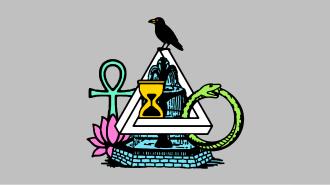Death doesn’t care about your story. It doesn’t care about race, gender, nationality, religion, or politics. Death is the “great leveller” – an egalitarian with a scythe. It comes for everyone, eventually, which is why human beings have written about it extensively.
Philosophers, ostensibly human, are no different. They are well known to have one eye on the Grim Reaper at all times. And so, the history of philosophy is strewn with thought experiments about both mortality and its mirror: immortality.
In philosophy, a thought experiment is a kind of mini-fiction that is designed to test our intuitions. A good thought experiment is supposed to be so obvious that most rational, level-headed humans would agree with the author’s conclusions. When it comes to death and mortality, however, we have as many thought experiments as we have philosophers — and as many philosophers as we have opinions. Here are five types of immortality from the history of philosophy — and what they can teach us about our time on Earth.
Eternal recurrence
“What, if some day or night a demon were to steal after you into your loneliest loneliness and say to you: ‘This life as you now live it and have lived it, you will have to live once more and innumerable times more; and there will be nothing new in it, but every pain and every joy and every thought and sigh and everything … will have to return to you, all in the same succession and sequence…’”
— Friedrich Nietzsche, “The Gay Science,” 1882
The idea of “eternal recurrence” did not start with Nietzsche. Reincarnation and the transmigration of the soul are some of the earliest religious beliefs. And even this specific version — where you have to relive the very same life, again and again — can be found in ancient Greece. But, in Nietzsche’s hands, it comes with a different message.
The immortality here is a kind of “Groundhog Day” repetition. You have to do the same things over and over again. You get the same parents, the same childhood home, the same classmates. You relive all the love and grief, health, and sickness — in the same order. Forever. The big question is: How does that make you feel?
Nietzsche uses this question to alert us to a wasted life. If the prospect of doing this again makes us uneasy, then something is amiss. If we have only one life, then we should use it to such fullness that we want to do it again and again.
Surprisingly, there have been some attempts to scientifically rationalize Nietzsche’s idea.
Today, there is the theory of “cyclic cosmology,” where time, entropy, and aging happen only because of an expanding universe. Under this theory, when the universe reaches its elastic peak, it will bounce back – and so everything will be in reverse. We will undie, unage, and be unborn. Then, the Big Bang will start it again. There’s not much real scientific support for this theory. But Nietzsche did hint in unpublished notes to his sister that he may have believed in it.
Forever old
“[The ‘Struldbrugs’] acted like mortals till about 30-years-old, after which they grew melancholy and dejected, increasing in both till they came to fourscore when they had not only all the follies and infirmities of other old men, but many more, which arose from the dreadful prospect of never dying. They were incapable of friendship, and dead to all natural affection, and find themselves cut off from all possibility of pleasure; and whenever they see a funeral they lament and repine that others are gone to a harbour of rest, to which they themselves never can hope to arrive.”
— Jonathan Swift, “Gulliver’s Travels,” 1726
The Struldbrugs are an immortal species with mortal physical bodies. They go on and on and on, but never die. In Greek mythology, Tithonus was granted immortality but not eternal youth — he aged into a withered, shriveled form, begging for death. Immortality becomes a curse when physical aging continues unabated.
Life is not, inherently, good. It’s what life lets you do that’s good. When people imagine living forever, it’s often in the prime of health: handsome, fit, lucid, and with a full set of teeth. They don’t imagine themselves like the Struldbrugs. Longevity for its own sake is a peculiar idea. As Tithonus and Gulliver knew, it’s also a hellish one.
This reality led the philosopher Michel de Montaigne to build a kind of existentialist philosophy: that a good, full life is not about the number of days you have but what you use those days for. A week enjoying life and savoring the joys of the world is better than a million locked in a damp, Platonic cave. As Montaigne put it, “The utility of living consists not in the length of days, but in the use of time; a man may have lived long, and yet lived but a little … It depends upon your will, and not upon the number of days, to have a sufficient length of life.”
While there might be a modest extension in human life and health — maybe 10 years or so — more dramatic gains in longevity are unlikely this century. A study published in Nature Aging argued that the percentage of people living to 100 is unlikely to exceed 15% for women and 5% for men.
At the same time, the reality of growing older persists: Physical mobility and independence decline as our muscles, joints, sensory systems, and neural control creak and crack. And, of course, with greater age will come age-related dementia. So we may soon live in a world of slightly increased longevity, but Swift’s vision might not be too far off.
Forever young
“‘It was because I heard father and mother … talking about what I was to be when I became a man.’ He was extraordinarily agitated now. ‘I don’t want ever to be a man,’ he said with passion. ‘I want always to be a little boy and to have fun. So I ran away to Kensington Gardens and lived a long long time among the fairies.’”
— J. M. Barrie, “Peter and Wendy,” 1911
As you can imagine, the notion of eternal youth is far more popular than that of the Struldbrugs. Oh, to stay as a forever child, carefree and cared for. Life is less complex for a child — it’s about eating, sleeping, and playing.
But there’s something both alluring and disturbing about Barrie’s Neverland. The notion of staying a child forever seems both irresponsible and foolish. It’s foolish because the joy of childhood comes from being looked after — food appears, the bed is made, and the medicine cabinet is always full. But it’s impossible to imagine a society where everyone is forever looked after. It’s disturbing because a life spent being only young seems like a curse. In Anne Rice’s book “Interview with the Vampire,” there is a character named Claudia who becomes a vampire at five years old. Immortality experienced as a tiny child, with an adult’s emotions and thoughts, is just as hellish as the immortality of Tithonus.
Nor is life better if we imagine eternal young adulthood. Immortality in our prime is probably the most appealing of all immortalities, but even here, philosophers doubt its appeal. In his work “Either/Or,” Søren Kierkegaard argues that the life of constant youthful pleasure will eventually grow stale and tedious. The “aesthete” who spends life hopping from this thrill to that will, before long, fall into a kind of listless depression. Likewise, the philosopher Bernard Williams argues that eternal life with unchanging character and desires would become intolerable, as one would exhaust the limited set of interests that give life meaning.
Chinese and Japanese philosophers are much more attuned to the idea that life is about the movement of age. It stays exciting not because of the many different things we see or do. It’s exciting because we change just as much as the world. In every stage of life, we are reborn.
Science has given us some hope that we can reverse the aging process, but the research is still in its infancy. Certain interventions — such as gene therapies, cellular reprogramming, and senolytic drugs — have looked good in preclinical and early human trials for delaying age‑related cognitive dysfunction and physical frailty. There’s also some research on a family of proteins called sirtuins that might help regulate DNA repair and inflammation. Tests using sirtuins appear to extend the lifespan of mice by about 15%. But humans are not mice, and there’s still a long way to go.
Material incorporeality
“It was as though everything was stripped away: sensation, memory, self, even the notion of existence that underlies reality — all seemed to have vanished utterly, their passage marked only by the realization that they had disappeared, before that too ceased to have any meaning, and for an indefinite, infinite instant, there was only the awareness of something; something that possessed no mind, no purpose and no thought, except the knowledge that it was.
After that came a rebuilding, a surfacing through layers of thought and development, learning and shape‑taking, until something that was an individual, possessing shape and capable of being named, woke.”
— Iain M. Banks, “Feersum Endjinn,” 1994
A favorite trick of philosophical immortalists is to focus on the distinction between mind and body — or even question whether such a distinction makes sense. Philosophers, writers, and theologists have long argued that who we are is tied to our mental life. My identity exists in my head — it’s the thoughts, emotions, desires, and memories that make me, me.
But could we recreate those elements of me without a body? Plato’s “Phaedo” considers a thinking soul existing without a form. John Locke imagined the implications of a body swap between a prince and a pauper, and Chuang Tzu asked whether we might not be a butterfly dreaming of being a human. In the digital age, the thought experiments have changed in setup, if not philosophical endpoint. “The Matrix,” “Black Mirror,” and Ted Chiang all explore the idea that our minds can be moved out and about from our bodies. The philosopher Derek Parfit presented his “teletransporter” thought experiment, where we atomize the body and reconstitute it identically somewhere else. Is it still you?
The most popular example today of this type of thought experiment is found in the futurology of transhumanists. Why not upload our consciousness? Why not digitize our identity? If the mind is the brain, and the brain is just architecture, why not jettison these cumbersome flesh sacks weighing us down?
Maurice Merleau-Ponty was one of the first to popularize the pushback against this kind of techno-dualism. For him, the body was not some useless appendage, irrelevant to our mind’s working. As he put it, “I am not in front of my body, I am in it — or rather, I am it.”
Today, philosophers and psychologists agree. Antonio Damasio’s idea of “somatic markers” and Krista Thomason’s emotional theory of cognition both point to the fact that our bodies are inseparably enmeshed with our minds. But with the super-developments in artificial neural networks and the seemingly remarkable output of their large language models, it’s only a matter of time before philosophy hits the tarmac of reality.
Of course, we’re not really that close to uploading a human mind. Whole-brain emulation remains speculative — no full human “connectome” exists, and even being able to map 76,000 neurons in a mouse’s brain is cutting-edge. Brain-computer interfaces like Neuralink and Synchron are helping paralyzed people communicate by thought. These are hugely impressive and life-changing technologies, but capturing memory, identity, desire, is more than any simple digital architecture.
Immortality projects
“People look enviously at Homer and Hesiod and other great poets, because of the kind of legacy they have left behind them, which provide them with immortal fame and remembrance by being immortal themselves … [Those creators] would be immortal, if mortal man may.”
— Plato, “The Symposium,” 4th century BC
Legacy is another form of immortality, one that writers from Plato to Hemingway explored in detail. The latter is credited as once saying, “Every man has two deaths, when he is buried in the ground and the last time someone says his name. In some ways men can be immortal.” In “The Iliad,” Achilles is given a choice: a long, quiet life or a short life with undying fame. Of course, being a Greek hero, he chooses immortal glory through heroic deeds. Today, the concept of naming a building, an invention, or a discovery after yourself (or preserving your digital presence indefinitely online) reflects the same need: to create something that outlives our biological life. Ernst Becker called these “immortality projects,” where we try to do something that lasts after we live. It might be that we contribute to world science, write a book, or plant a tree — the shade of which we will never enjoy.
The most common immortality project for both Becker and Plato comes in the need to have children. We live on in the genes of our progeny.
Despite our best efforts, all humans will die — your children, grandchildren, and millennia-distant descendants — and your genes won’t fare much better. All the immortality projects we pursue are, if Ecclesiastes is to be believed, actually “vanity projects.” At the very least, the sun will eventually die, destroying the entire planet. But it’s more likely your tree will die long before that.
There is a small glimmer of philosophical hope. And that’s to see your actions as a tiny drop in the vast, swirling ocean of the universe. No matter what comes after us, the fact of our existence cannot be taken away. I will always have written this article. You will always have read it. We will both have existed on this planet together.
Sign up for the Mini Philosophy newsletter, a place to pause and reflect on life’s bigger questions, with Big Think’s Jonny Thomson.
We’d love to hear from you! If you have a comment about this article or if you have a tip for a future Freethink story, please email us at [email protected].





















